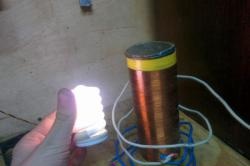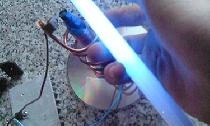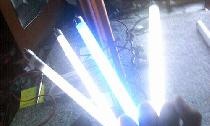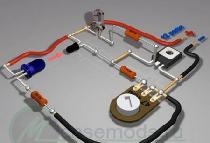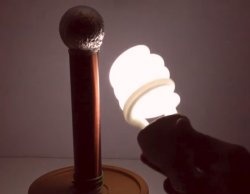Kacher Brovina and Tesla transformer
Kacher is a device that generates high voltage (5000-20000 volts) of high frequency. Don't be afraid - you won't be electrocuted. This is not the same current as in a socket - it has a high frequency (up to 250 kHz), and in our socket it is 50 Hz. At high frequency, current flows across the surface of your body.
The simplest circuit is shown in Figure 1. In order to assemble this circuit, you will need a minimum of parts that can be found in old TVs:

1. 2 resistors
2. 1 p-n-p junction transistor (it must be powerful and high-frequency, for example
kt805. See the catalogue)
3. 1 Capacitor
4. Copper wire 0.15 - 0.25 mm (can be purchased at a radio store or by unwinding any power transformer)





We buy resistors or unscrew them from any radio boards. You can also remove the capacitor from the boards. The transistor can also be unscrewed from the board - they are usually mounted on radiators. Pay attention to the fact that the transistor has a p-n-p junction; if there is an n-p-n junction, you need to change the connection places of the collector and emitter.What can be said about the radiator, it should be large, and if you do not have a large radiator, then install a cooler on a small radiator. We take copper wire from any transformer.

Now let's start assembling:
We take a cardboard tube and wind the secondary winding turn to turn with wire (0.15-0.25), periodically filling it with varnish. This is the most painstaking work. The more turns, the better the final result. Now around the secondary winding we make 3-4 turns with a thicker wire (wire, plate) whose thickness (width) should be 1-4 mm. Next, we connect these 2 windings to the circuit and connect this device to the network. And what do we see? When you bring a fluorescent lamp to this device, it lights up without wires... We can conduct electricity through the body without harming any organ, to do this, it is enough to bring your hand to the secondary winding and with the other hand grab tightly to one of the contacts of the fluorescent lamp...


Note: If the device does not work, then turn over the primary winding, i.e. The magnetic fields of the windings must match. If you wind one winding clockwise, then the second one should be wound in the same way.







The simplest circuit is shown in Figure 1. In order to assemble this circuit, you will need a minimum of parts that can be found in old TVs:

1. 2 resistors
2. 1 p-n-p junction transistor (it must be powerful and high-frequency, for example
kt805. See the catalogue)
3. 1 Capacitor
4. Copper wire 0.15 - 0.25 mm (can be purchased at a radio store or by unwinding any power transformer)





We buy resistors or unscrew them from any radio boards. You can also remove the capacitor from the boards. The transistor can also be unscrewed from the board - they are usually mounted on radiators. Pay attention to the fact that the transistor has a p-n-p junction; if there is an n-p-n junction, you need to change the connection places of the collector and emitter.What can be said about the radiator, it should be large, and if you do not have a large radiator, then install a cooler on a small radiator. We take copper wire from any transformer.

Now let's start assembling:
We take a cardboard tube and wind the secondary winding turn to turn with wire (0.15-0.25), periodically filling it with varnish. This is the most painstaking work. The more turns, the better the final result. Now around the secondary winding we make 3-4 turns with a thicker wire (wire, plate) whose thickness (width) should be 1-4 mm. Next, we connect these 2 windings to the circuit and connect this device to the network. And what do we see? When you bring a fluorescent lamp to this device, it lights up without wires... We can conduct electricity through the body without harming any organ, to do this, it is enough to bring your hand to the secondary winding and with the other hand grab tightly to one of the contacts of the fluorescent lamp...


Note: If the device does not work, then turn over the primary winding, i.e. The magnetic fields of the windings must match. If you wind one winding clockwise, then the second one should be wound in the same way.







Similar master classes
Particularly interesting
Comments (81)

